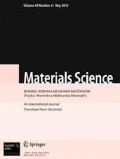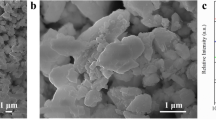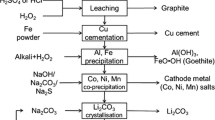We study the properties of ZrO2 –Y2O3 –NiO ceramics obtained by using the technologies of sintering of powders and tape casting in the intact state and after one-time reduction both in pure hydrogen and in Ar–5% H2 and N2 –10% H2 –5% CO2 mixtures. It is demonstrated that, by using the technology of tape casting, it is possible to obtain materials for anodes-substrates of solid-oxide fuel cells with smaller grains and a more uniform structure, which improves their strength characteristics. It is shown that, in the hydrogen-containing medium containing carbon dioxide (N2 –10% H2 –5% CO2 ), the strength of 8YSZ–Ni cermet decreases as its electric conductivity increases as compared with the material reduced in the Ar–5% H2 mixture.



Similar content being viewed by others
References
F. M. Sapountzi, S. Brosda, K. M. Papazisi, S. P. Balomenou, and D. Tsiplakides, “Electrochemical performance of La0.75Sr0.25Cr0.9M0.1O3 perovskites as SOFC anodes in CO/CO2 mixtures,” J. Appl. Electrochem., 42, 727–735 (2012).
A. Hagen, A. Winiwarter, H. Langnickel, and G. Johnson, “SOFC operation with real biogas,” Fuel Cells, 17 (6), 854–861 (2017).
J. Fergus, R. Hui, X. Li, D. Wilkinson, and J. Zhang (editors), Solid Oxide Fuel Cells. Materials Properties and Performance, CRC Press, Boca Raton (2019).
B. Sarruf, J. Hong, R. Steinberger-Wilckens, and P. De Miranda, “CeO2–Co3O4 –CuO anode for direct utilization of methane or ethanol in solid oxide fuel cells,” Int. J. Hydr. Energy, 43, 6340–6351 (2018).
B. Vasyliv, V. Podhurska, and O. Ostash, “Preconditioning of the YSZ–NiO fuel cell anode in hydrogenous atmospheres containing water vapor,” Nanoscale Res. Lett., 12, 265 (2017); DOI: https://doi.org/10.1186/s11671-017-2038-4.
B. D. Vasyliv, V. Ya. Podhurska, O. P. Ostash, and V. V. Vira, “Effect of a hydrogen sulfide-containing atmosphere on the physical and mechanical properties of solid oxide fuel cell materials,” in: O. Fesenko and L. Yarsenko (editors), Nanocomposites, Nanostructures, and Their Applications, Springer, Berlin (2018), pp. 475–485.
B. D. Vasyliv, V. Ya. Podhurs’ka, O. P. Ostash, O. D. Vasyl’ev, and E. M. Brodnikovs’kyi, “Influence of reducing and oxidizing media on the physicomechanical properties of ScCeSZ–NiO and YSZ–NiO ceramics,” Fiz.-Khim. Mekh. Mater., 49, No. 2, 5–13 (2013); English translation: Mater. Sci., 49, No. 6, 135–144 (2013).
A. S. Thorel, “Tape casting ceramics for high temperature fuel cell applications,” in: W. Wunderlich (editor), Ceramic Materials, Tokai University, Tokyo (2010), pp. 49–67.
J. Chao, M. Yachun, Z. Naiqing, and S. Kening, “Fabrication and characterization of Ni–ScZ gradient anodes/SSZ electrolyte for anode-supported SOFCs by tape casting and co-sintering technique,” Int. J. Hydr. Energy, 40, 8433–8441 (2015).
M. Letilly, O. Joubert, M.-T. Caldes, and A. Le Gal La Salle, “Tape casting fabrication, co-sintering and optimization of anode/electrolyte assemblies for SOFC based on BIT07-Ni/BIT07,” Int. J. Hydr. Energy, 37, 4346–4355 (2012).
I. Polishko, S. Ivanchenko, R. Horda, Y. Brodnikovskyi, N. Lysunenko, and L. Kovalenko, “Tape casted SOFC based on Ukrainian 8YSZ powder,” Materials Today: Proceed., 6, 237–241 (2019).
GOST 2409–2014. Refractory Materials. Method for the Determination of the Apparent Density, Open and Total Porosities, and Water Absorption [in Russian], Standartinform, Moscow (2014).
L. J. Van der Pauw, “A method of measuring specific resistivity and Hall effect of discs of arbitrary shape,” Philips Res. Reports, 13, 1–9 (1958).
V. Podhurska, B. Vasyliv, O. Ostash, Y. Brodnikovskyi, and O. Vasylyev, “Influence of treatment temperature on microstructure and properties of YSZ–NiO anode materials,” Nanoscale Res. Lett., 11, 93 (2016); DOI: https://doi.org/10.1186/s11671-016-1306-z.
R. M. C. Clemmer and S. F. Corbin, “The influence of pore and Ni morphology on the electrical conductivity of porous Ni/YSZ composite anodes for use in solid oxide fuel cell applications,” Solid State Ionics, 180, 721–730 (2009).
Author information
Authors and Affiliations
Corresponding author
Additional information
Translated from Fizyko-Khimichna Mekhanika Materialiv, Vol. 56, No. 1, pp. 21–26, January–February, 2020.
Rights and permissions
About this article
Cite this article
Vasyliv, B.D., Podhurska, V.Y., Ostash, O.P. et al. Influence of the Working Media of Fuel Cells on the Structure and Physicomechanical Characteristics of Ceramics of the ZrO2–Y2O3–NiO System. Mater Sci 56, 15–21 (2020). https://doi.org/10.1007/s11003-020-00391-4
Received:
Published:
Issue Date:
DOI: https://doi.org/10.1007/s11003-020-00391-4




